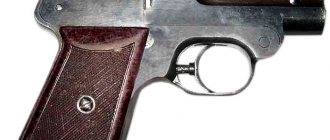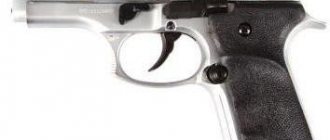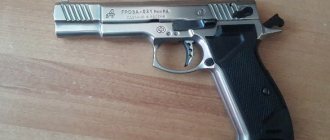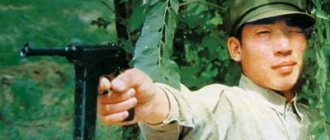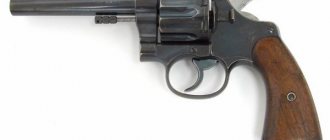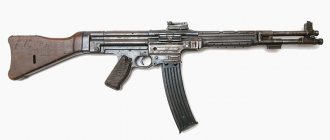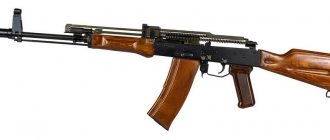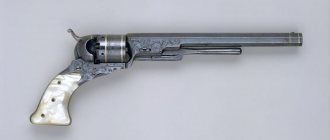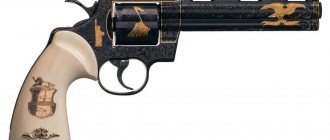Military action is always a tragedy. To a greater extent, it is human, because soldiers and officers say goodbye to life. Although a lot depends on the type of weapon used. Previously, in more ancient times, piercing and cutting weapons were used - swords, spears, swords, sabers. Later, with the advent of gunpowder in Europe, weapons became more dangerous: after all, there was little chance of survival from piercing weapons, but practically none from gunpowder. The first pistols appeared, then guns. Like everything in the world, weapons have been improved over the centuries. By the beginning of the 20th century, swords and knives were already a thing of the past. Now gunpowder and bullet weapons have become the main thing in the military arena. And the First World War clearly showed this.
People showed sophistication and ingenuity in creating weapons that could kill or maim as many people as possible. We look at the major weapons that have killed millions of people in four short years.
Rifles
Throughout the war, all participating countries used several types of rifles. Were introduced:
- modifications of the Lee-Enfield 303 rifle (mostly Great Britain and Commonwealth countries);
- modifications of the Lebel and Berthier rifles (Berthier rifle), 8 mm (France);
- Mannlicher-Carcano Mo. 1891 6.5 mm (Italy. We cannot fail to mention that almost 50 years later John Kennedy would be killed with a rifle of this brand).
Russia also had its own rifles, manufactured at Russian factories (sometimes the products were purchased abroad). The most common rifle in Russia was the Mosin-Nagant rifle, model 1891, 7.62 mm.
The Americans used only their own production - the Springfield 1903 rifle chambered for 30-06, but this weapon was an almost exact copy of the famous Mauser, and the American government was forced to pay a fine and officially begin joint production of rifles. You also can’t ignore the Mondragon rifle. The parts were developed in Mexico, which was surprising given the level of technical capabilities in the country. And what’s most amazing is that it was the first self-loading rifle. The caliber of the rifle was 7 mm, and the number of cartridges in the magazine was 10.
The Central Powers involved in the war preferred the Steyr-Mannlicher M95 rifle (widely used by Austria-Hungary, Germany, Bulgaria). The legendary Mauser rifle was also in use: Mauser M98G 7.92 mm in Germany, Mauser M1877 7.65 mm in Turkey.
Pistol "Roth-Steyr" mod. 1907 (Austria-Hungary)
A famous ammunition designer, owner of two cartridge factories in Vienna and Pressburg (now Bratislava), Austrian engineer Georg Roth at the end of the 19th century. became interested in a new type of activity at that time - the production of self-loading pistols. In 1898, the already well-known weapons designer Karel Krnka became the manager of one of the Roth factories. Already in 1900 they patented the first sample of a pistol. Now it is difficult to say what part of the work on the creation of this weapon was carried out by each of them. Most likely, Krnka was still the main designer, and Roth supplied him with ideas, cartridges and production capabilities.
Pistol "Roth-Steyr" mod. 1907
For some time the Rota-Krnka pistol mod. 1900 was produced in small batches by the German company, and is therefore also known under the designation “Roth-Sauer”.
Along with the appearance of Roth's first pistol, his cooperation with the factory in Steyr improved. In 1904, the first prototypes of Roth-Steyr pistols appeared. Their improvement continued until 1907, when the model was adopted by the cavalry units of the Austrian-Hungarian army. The 1907 version differed from other models of that time by an enlarged magazine, a different locking system and original ammunition, which used a wafer-shaped Roth cartridge of 8 mm caliber.
The Roth-Sauer pistol has an automatic mechanism based on the use of recoil energy from the barrel engaged with the bolt during its long stroke. Locking occurs by turning the bolt. The barrel is equipped with two pairs of protrusions, one pair is attached to the receiver, the other pair engages the bolt. The trigger is external.
Pistol arr. The 1907 was never sold on the commercial market. For the Hungarian Honved - an integral part of the army of Austria-Hungary - it was produced in Budapest. It was produced for the Austrian units of the Austro-Hungarian army. Production was completed around 1914, and about 50,000 of these pistols were produced in Steyr from 1908 to 1913, in Budapest - in 1911-1914. - about 30,000. Also, a small number of copies were assembled from the remaining parts after the end of the First World War. In addition, the allies received the Roth-Steyr batch, requisitioned from the collapsed Austria-Hungary. 1907. Subsequently, this weapon was used by the Italian army until 1941.
Pistols
In the hands of the soldiers there were not only rifles, but also pistols. Here it is also worth paying attention to this type of weapon, the more they were improved, they were already small in size (remember the novels about musketeers - huge and inconvenient pistols to use). Which ones were used during the war?
Of course, Mauser is in the forefront - various calibers and 10-round magazines are presented. The officer's pistol Parabellum (or Luger) can also be attributed to the list of weapons of the First World War: it had a caliber of 9 mm and was created on Austrian soil by gunsmith Georg Luger. A distinctive feature of this weapon was maximum accuracy when shooting (of course, any shooting soldier must shoot accurately, but this particular pistol allowed a more accurate shot).
Also presented is the Dreyse pistol, which originated in Germany. It was also self-loading, had a caliber of 9 mm and a number of bullets in the magazine of 8. Like any weapon, the pistol had a number of disadvantages - for example, it was quite large and heavy in weight, but it provided powerful protection.
Use of captured German pistols in the USSR
It is no secret that for many Soviet officers owning a captured pistol was very prestigious. Most often, German short-barreled weapons could be at the disposal of infantry platoon-battalion commanders and military personnel of reconnaissance units. That is, those who were directly on the front line or went behind the front line.
Pistols chambered for 9×19 mm Parabellum
Although the armed forces of the Third Reich had many different types of short-barreled weapons, our soldiers usually captured Luger P.08 and Walther P.38 pistols.
To fire from them, they used the 9x19 mm Parabellum cartridge, which was quite powerful for that time, which at distances (typical for shooting from short-barreled weapons) provided a good stopping and lethal effect. The Luger P.08 pistol (also known as the Parabellum) was adopted by the Kaiser's army in 1908. The automatic operation of the pistol is based on the use of recoil with a short barrel stroke. The barrel bore is locked using an original system of hinged levers. In fact, the entire hinge-lever system of the pistol is a crank mechanism in which the slide was the bolt.
9 mm Luger P.08 pistol.
At the time of adoption, the Parabellum was perhaps the best 9-mm semi-automatic pistol, and for quite a long period of time it was considered as a kind of standard.
One of the main advantages of the Parabellum is its high shooting accuracy, achieved through a comfortable handle with a large angle of inclination and easy release. Compared to other military pistols of the time, it combined high power with sufficient compactness. All Luger P.08 pistols had high quality workmanship, good external finish and precise fitting of moving parts. Metal surfaces were blued or phosphated. On weapons of early production, the cheeks of the handle were made of walnut wood, with a fine notch. However, pistols produced during World War II may have had dark plastic cheeks. The weight of the loaded weapon was about 950 g, the total length was 217 mm, and the barrel length was 102 mm. Magazine capacity – 8 rounds. Rate of fire - about 30 rounds per minute. Sighting range – up to 50 m. Initial bullet speed – 350 m/s. To arm personnel directly involved in hostilities, a modification was made with a barrel length of 120 mm. From 10 m, a bullet fired from this pistol pierced a German steel helmet. At a distance of 20 m, the bullets were placed in a circle with a diameter of 7 cm.
During the First World War, the Lange P.08 pistol, also known as the “Artillery Model,” was produced. It was intended to arm crews of field artillery guns and non-commissioned officers of machine gun teams. The long barrel and the possibility of attaching a rigid holster-butt to the weapon significantly increased the firing range.
9-mm pistol Lange R.08.
The “artillery” pistol had a total length of 317 mm and an unloaded weight of 1,080 kg. The bullet left a 203 mm long barrel with an initial speed of 370 m/s. The pistol could be equipped with a Trommelmagazin 08 drum magazine for 32 rounds. Although the sights of this weapon were designed for a distance of up to 800 m, the effective firing range with an attached holster-butt did not exceed 100 m. Despite the higher cost, more than 180,000 Lange P.08 pistols were produced from 1913 to 1918. Subsequently, the “Artillery Model” (as pistols with a barrel length of 102 and 120 mm) was in service in the Wehrmacht, the SS, Kringsmarine and Luftwaffe. The exact number of Lugers produced is not known. According to some reports, up to 3 million copies could have been produced. According to a number of sources, the German armed forces received about 2 million pistols from 1908 to 1944.
However, with all the positive qualities of the Parabellum, it had serious drawbacks, the most important of which was the high cost and complexity of production. In 1939, for the Wehrmacht, the cost of one pistol with three magazines was 32 Reichsmarks, while at the same time the Mauser 98k rifle cost 70 Reichsmarks. In addition, the need to manually refine some parts required the use of highly skilled workers, which greatly limited production volume.
In this regard, in the early 1930s, Carl Walther Waffenfabrik began designing a new semi-automatic pistol chambered for the 9 mm Parabellum cartridge. In this case, the developments obtained in the creation of the very successful 7.65-mm Walther PP pistol, which had an automatic blowback mechanism, were used. But due to the fact that the power of the 9-mm cartridge was significantly higher, the automatic operation of the new pistol was based on the use of recoil energy with a short barrel stroke. The barrel is locked by a latch that swings in a vertical plane and is located between the barrel lugs. The trigger mechanism is double action, with an open trigger.
9mm P38 pistol next to the holster.
The pistol created by the Wehrmacht officially entered service with the Wehrmacht on April 20, 1940 under the designation P.38 (Pistole 38). This pistol was mass-produced at factories in Germany, Belgium and the Czech Republic. P.38 pistols were originally produced with walnut grips, but these were later replaced with bakelite grips.
Depending on the year and place of production, the weight of the pistol was 870–890 g. Length – 216 mm, barrel length – 125 mm. Magazine capacity – 8 rounds. The initial bullet speed is 355 m/s.
In the second half of 1943, the number of 9-mm Walters in the active army became greater than Luggers. However, both pistols were in service until the surrender of Nazi Germany. In 1944, by order of the Main Directorate of Imperial Security, a version with a P.38K barrel shortened to 73 mm was created and produced.
9 mm pistol P.38K.
In total, the armed forces of the Third Reich received about 1 million P38 pistols. During combat operations, the P.38 demonstrated sufficient efficiency, good operational reliability, a high degree of safety in handling and shooting accuracy. Among the advantages of "Walter" is an excellent combination of combat and service characteristics for its time. The pistol was safe when loaded; the owner could open fire at any time or determine by touch whether the weapon was loaded. But, despite the high quality of workmanship and other positive characteristics traditional for German weapons, the P.38 still had several rather significant shortcomings.
Although "Walter" turned out to be simpler and cheaper to manufacture than "Parabellum", it still turned out to be quite complex, had many parts and springs. The P.38's grip is excessively thick for a pistol with a single-stack magazine, which makes it not very comfortable for shooters with small hands. In addition, it turned out that the R.08 with a 120 mm barrel was superior in accuracy to the R.38, which had a 125 mm barrel. The quality of workmanship and finishing of the R.38 pistols produced at the end of the war greatly decreased, which negatively affected reliability.
Pistols chambered for 7.65 mm Browning
Unfortunately, the format of this publication does not allow us to talk about all the pistols used in the armed forces of Nazi Germany.
But it would be wrong not to mention the widespread compact pistols chambered for 7.65x17 mm. During World War II, the most common German 7.65 mm pistols were Walther PP, Walther PPK and Mauser HSc. After defeat in the First World War, the production of weapons in Germany was limited by the terms of the Treaty of Versailles: caliber no more than 8 mm and barrel length no more than 100 mm. In 1929, Carl Walther GmbH created the Walther PP (Polizeipistole) pistol chambered for the 7.65×17 mm cartridge, popular at that time. The pistol was originally designed as a police weapon and as a civilian means of self-defense.
7.65 mm Walther PP pistol.
The automatic operation of the pistol is based on the use of blowback recoil.
This became possible thanks to the use of a relatively low-power “civilian” cartridge. The bolt-casing is held in the extreme forward position by a return spring located on the barrel. The trigger mechanism is hammer type, double action. Allows firing with both pre-cocked and released hammers. This arrangement makes the pistol as compact as possible, simple, easy to handle, safe, and when the cartridge is loaded, it makes it possible to quickly open fire. The design of the trigger mechanism includes a hammer release and its safety cocking - qualities that are important for safety. There is also an indicator of the presence of a cartridge in the chamber, which is a rod, the back of which protrudes beyond the surface of the bolt-casing above the trigger when the weapon is loaded. This device makes the gun much safer, since the owner can determine whether a cartridge is in the chamber even by touch.
The pistol turned out to be quite convenient, relatively light and compact. Weight without cartridges is 0.66 kg. Total length – 170 mm. Barrel length – 98 mm. The initial bullet speed is 320 m/s. Sighting range - up to 25 m. Magazine for 8 rounds.
Although the Walther PP's power did not meet the military's requirements, its great popularity among the personnel of the German police and security services, as well as its success in the civilian market, attracted the attention of the heads of the armament department of the ground forces. In the second half of the 1930s, due to Germany's refusal to accept restrictions imposed by the Treaty of Versailles and a sharp increase in the number of personnel, the German armed forces experienced a shortage of pistols. The reserves available at that moment did not satisfy the army’s demands, and the deployment of the required volumes of production of regular army pistols was still far away. In order to somehow fill the vacuum that has arisen in the small arms system, it was decided to begin purchasing non-standard service and civilian short-barreled weapons of 7.65 mm caliber.
To be fair, it must be said that the 7.65 mm Walter was actually quite good. Lighter and more compact (compared to the Parabellum), it turned out to be quite suitable for arming officers not directly involved in combat operations. Due to its small dimensions, this weapon made it possible to carry it secretly, which was valued by operatives of the police and security services who carried out operational search activities in civilian clothes. Police “Walters” quite often had crews of armored vehicles, pilots, sailors, couriers and staff officers. Until April 1945, German government agencies, intelligence services, police and armed forces received about 200,000 Walther PP pistols.
In 1931, a shortened and lightweight Walther RRK (Polizeipistole Kriminal) pistol appeared, which was created on the basis of the Walther PP, but at the same time had some original features. The design of the frame and the shutter-casing was slightly changed, receiving a different shape for the front part. The barrel length decreased by 15 mm, the total length by 16 mm, and the height by 10 mm. Weight without cartridges - 0.59 kg. The initial bullet speed is 310 m/s. Magazine for 7 rounds.
7.65 mm Walther RRK pistol.
Walther PP and Walther RRK pistols were produced in parallel. During the Nazi years in power, Carl Walther supplied the German army, police and paramilitary forces with approximately 150,000 Walther RRK pistols. During the war, they were, as a rule, used by officers of the Luftwaffe, rear units of the ground forces, as well as the command staff of the Wehrmacht.
Another 7.65 mm pistol adopted by Nazi Germany was the Mauser HSс (Hahn-Selbstlspanner pistole ausfurung C). Mass production of this elegant pistol began in 1940. It was developed as a compact self-defense weapon, suitable for concealed carry, and is a self-loading pistol built on a blowback automatic and having a double-action trigger mechanism. Pistols of early production were distinguished by excellent quality of workmanship and surface treatment; they were equipped with walnut grip cheeks.
7.65 mm Mauser HSс pistol.
The weight of the Mauser HSс pistol without cartridges is 0.585 kg. Length – 162 mm. Barrel length – 86 mm. Magazine capacity – 8 rounds. The width is 27 mm, which is 3 mm less than the Walther PP.
7.65 mm Mauser HSc pistol with holster.
The pistol's shape and sights are optimized for concealed carry. The small height front sight is hidden in a longitudinal groove and does not protrude beyond the outline of the weapon. The trigger is almost completely hidden by the bolt, and only a small flat spoke protrudes outward, allowing you to cock the trigger manually if necessary, but practically eliminating the possibility of the trigger catching on clothing when snatching the weapon. Over five years, more than 250,000 Mauser HSc pistols were produced. They were mainly armed with senior and senior command personnel, secret police, saboteurs, Luftwaffe and Kringsmarine officers.
A common feature of the 7.65 mm Walther PP/PPS and Mauser HSc pistols was that at a distance of 15–20 m they had better accuracy than the 9 mm P.08 and P.38 pistols. Due to their lighter weight, they were easier to control, and the recoil and roar of the shot were more easily tolerated by the shooter. At the same time, a 9-mm cartridge with a muzzle energy of about 480 J was more than twice as large as a 7.65-mm cartridge with a bullet energy of 210–220 J. This (in combination with a larger caliber) meant that the “Parabellum” A 9 mm bullet, when hit in the same part of the body as a 7.65 mm bullet, has a much greater likelihood of instantly incapacitating the target and depriving the enemy of the opportunity to fire a return shot.
Use of captured German pistols in the Red Army
It is not known how many German pistols the Red Army soldiers and partisans operating in the temporarily occupied territory managed to capture. But, apparently, we can talk about tens of thousands of units. It is quite obvious that in the second half of the war, when our troops seized the initiative and moved on to strategic offensive operations, there were much more captured small arms. Moreover, if rifles, submachine guns and machine guns captured from the enemy were centrally collected by captured teams, then the compact short-barreled weapon was often hidden by personnel.
It was common practice for soldiers to give captured pistols to commanders who deserved respect. “Lugers” and “Walters” were often used as additional weapons by snipers, military reconnaissance officers and fighters of sabotage groups. For underground fighters and partisans operating deep in the German rear, it was usually easier to get 9x19 and 7.65x17 mm cartridges than for Soviet weapons. Often, captured pistols became the subject of a kind of bargaining, when unit commanders exchanged various scarce property for them from the quartermasters, as a result of which a large number of unaccounted for short-barreled weapons formed in the hands of the rear guards.
I am sure that readers will be interested in comparing the German pistols mentioned in this publication with the Nagan system revolver mod. 1895 and a Tokarev self-loading pistol mod. 1933.
The Nagant revolver is certainly superior to all semi-automatic pistols in terms of reliability. Even if it misfired, you could simply pull the trigger again and quickly fire the next shot. In addition, the revolver demonstrated fairly high accuracy when firing with pre-cocking. At a distance of 25 m, a good shooter could place bullets in a circle with a diameter of 13 cm. But with all the advantages of the Nagan system revolver, a shooter armed with it could fire 7 shots in 10–15 seconds, after which each spent cartridge case had to be knocked out of the drum with a ramrod and loaded drum one cartridge at a time.
The TT pistol could fire up to 30 rounds per minute, which roughly corresponded to the rate of fire of German self-loading pistols. But at the same time, the German models were significantly superior to the TT in terms of ease of handling and were much more comfortable when shooting. The ergonomics of the TT leave much to be desired. The angle of inclination of the handle is small, the cheeks of the handle are thick and rough. Although the fixed pistol demonstrated very good combat accuracy and at a distance of 25 m the dispersion radius did not exceed 80 mm, in practice it was impossible to achieve such shooting accuracy. This was due to the fact that the trigger on the TT was tight and sharp, which, combined with poor ergonomics and powerful recoil, significantly reduced the shooting accuracy when using the pistol by an average shooter.
Perhaps the biggest drawback of the TT is the lack of a full fuse. Because of this, numerous accidents occurred. After a large number of unintentional discharges due to dropping a loaded weapon, it was prohibited to carry a pistol with a cartridge in the chamber.
Another disadvantage is the poor fixation of the magazine, which in combat conditions could lead to it falling out of the handle and being lost. Despite the fact that a very powerful 7.62x25 mm cartridge with an initial bullet speed of 420 m/s and very good penetration was used for firing from the TT, its stopping effect was significantly lower than that of the 9x19 mm cartridge.
The German 9-mm pistols “Parabellum” and “Walter” had a lifespan of up to 10,000 shots, and the Soviet TT was designed for 6,000 shots. However, only weapons used in shooting ranges could have such a large shot. In practice, in most cases no more than 500 shots were fired from pistols in combat units (before they were written off or transferred for storage). Partly, the shortcomings of Soviet pistols and revolvers were compensated by the fact that they were much simpler and cheaper to manufacture.
Use of captured German pistols in the post-war period
After the end of the war, many German-made pistols remained in the USSR, and not all of them were legal.
A significant amount of captured weapons ended up in the hands of criminal elements. NKVD/MGB officers who fought bandits needed a convenient, compact, but at the same time relatively powerful weapon. In this regard, in 1946–1948, several tens of thousands of 7.65-9 mm pistols entered service with the operational staff of the USSR Ministry of State Security, where they were used until the early 1960s, when they were replaced by domestic 9-mm pistols. mm PM pistols. In addition, captured 7.65 mm Walther PP and Walther PPK pistols have been the personal weapons of diplomatic couriers for quite a long time. Several thousand pistols were transferred to award funds and were used as personal weapons in the prosecutor's office and other government agencies. Currently, Walther PP and Walther PPK pistols are on the list of weapons that can be awarded to law enforcement officers, deputies and high-ranking officials. In total, our country has about 20,000 award pistols and revolvers. To be continued…
Machine guns
During the war, machine guns developed by the famous British gunsmith Hiram Maxim in 1884 were used. Such a weapon fired up to 600 rounds per minute, which was a kind of unique phenomenon at that time. The armies seriously hoped that machine guns would soon replace pistols and rifles - on the one hand, the use of the former was more advantageous against the enemy. So, what brands were used on the battlefields of World War I?
Skoda M 1909 1913 - produced in Austria-Hungary (the same plant developed the car).
Next on the list is the Hotchkiss, a French machine gun that was widely used on the battlefield. One should not think that the weapons were only of Central European production: the northern neighbors also did not stand aside. Denmark introduced the Madsen machine gun. It became the first light machine gun of that time. Of course, it was a bit heavy - 9 kg, but it was convenient to shoot, the soldier could defend himself both in a trench and on the move.
Another weapon is the Schwarzlose machine gun, made in Austria but also used by the German army. This machine gun was used even in World War II. It was quite simple in its composition. It was used by almost all countries participating in the hostilities.
Pistol "Mannlicher" mod. 1903 (Austria-Hungary)
“A model of aesthetic perfection”, “the most elegant weapon” - these were the epithets that weapons experts once awarded to the pistol of the Ferdinand Mannlicher system. The earliest examples were created in 1898.
Pistol "Mannlicher" mod. 1903
For production, the engineer turned to a company that already had experience in manufacturing rifles of his design. Since 1901, the pistol was produced by this company under a 7.63 mm cartridge, again created by Mannlicher, Pistol “Mannlicher” mod. 1901 is known primarily for being the world's first self-loading pistol with an open bolt-casing.
In 1903-1905. Tests of this weapon took place in the army of Austria-Hungary, which ended with the official refusal to accept the pistol for service. Nevertheless, in subsequent years, many officers of the Austro-Hungarian army purchased these weapons privately.
Now the pistol mod. 1903 is interesting primarily because it is the first weapon with an open bolt-casing. All modern pistols have exactly this design (albeit more modified).
Real success awaited Mannlicher's weapon in Latin America, where most of all ordered copies were sold. Under the designation “Moddlo 1904/1905” the pistol was adopted by the Paraguayan, Bolivian and Argentine armies. Suffice it to say that 7.63 mm Mannlicher cartridges are still produced in Argentina. In total, about 10,000 model pistols were produced. 1903
Flamethrowers
For the first time, such a weapon began to be widely used in ancient China, whose inhabitants knew the destructive power of fire and the secret of making gunpowder. During the American Civil War, there were rumors that President Abraham Lincoln secretly visited testing sites where such weapons were tested. For the first time in battle, hand-held flamethrowers were used in the infamous Verdun “meat grinder” in 1916 by the German side against the French army. The soldiers carried special tanks of nitrogen under pressure on their backs, which ignited the fuel oil coming out of a small branch pipe from the tank. Of course, other countries also produced similar weapons, but it was the Germans who put them into production.
Artillery
For successful combat, it was necessary to improve the armament of artillery troops - increase the range of the projectile, modernize the soldiers' ammunition and the design of the guns. Archival documents show that artillery salvoes killed more people than all other weapons combined. The French 75 mm gun deserved special attention from the enemy. It was nicknamed "the devil's pistol." They were even used in World War II. Military leaders of the French army claimed that it was these weapons that helped win the war.
Chemical weapon
Probably, no other weapon will stand next to this type of weapon. The first gas attack began on April 22, 1915, when the German army bombarded the city of Ypres with chlorine. From then on, gas attacks became commonplace on the battlefields of World War I as the Allies also rushed to build up their forces. All of Europe was covered with a gas cloud. It is difficult to calculate how many people died in the gas attack (they say not many), how many remained disabled. Chlorine primarily damaged the eyes and respiratory system, mustard gas caused the same thing, but added blisters and burns to the suffering when the skin came into contact with the drug. After the war, gas attacks were officially prohibited by law in all countries. However, it was sometimes used in other, later conflicts.
Navy
In addition to land, the war was also fought on the seas . In March 1915, the whole world heard terrible news: a German submarine sank the huge passenger ship Lusitania. More than a thousand civilians died in this incident. In 1917, the so-called unrestricted submarine warfare of German submarines began.
Germany openly announced its intention to sink not only enemy ships, but also the fleet of any other countries in order to deprive England of access to its allies and colonies, leaving it without bread and industrial raw materials. German submarines sank several hundred passenger and commercial ships in England and neutral countries.
Tanks
Even Leonardo Da Vinci was going to create land ships that would be safe for those inside. By the beginning of the war, the European powers already had tanks in their arsenal - some models maneuvered well. Of course, all this was imperfect - the first samples often broke down and were slow. At first, tanks entered the battle in small numbers to help the army. However, their number gradually increased, which ensured victory at the fronts.
Submarines
One should not think that submarines appeared only during the Second World War: even at the beginning of the 20th century, European countries and the United States were developing plans to create submarines against the German Empire. Great Britain was ahead of the rest, of course, and the Germans really wanted to overtake it. The main strength of submarines was their invisibility under water - it is difficult for the enemy to see the depth, so they can strike. Gradually they also improved: nuclear submarines soon appeared - more terrible weapons.
Unfortunately, no matter how modern weapons are, they perform one single function - kill people. But the history of mankind is one of constant wars, and therefore weapons cannot but improve.
